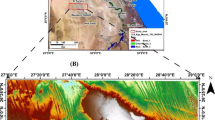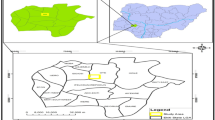Abstract
High-resolution airborne magnetic data of Oyo Metropolis has been used to map subsurface geological features which in most cases, corresponds to the area of interest for mineral expedition. The airborne magnetic data was first reduced to the magnetic equator (RTE); this is normally done to make the data simpler to interpret. The RTE map was subjected to Fast Fourier Transform to separate the regional and residual magnetic anomalies and estimate their depths. An average depth of 2500 m and 500 m were obtained for the top of regional and residual sources respectively. 3D-Euler deconvolution and tilt derivative interpretation techniques were combined and used on the RTE map, to locate and estimate depths to geologic contacts and pegmatite intrusions attributed to lineaments. The resulting 3D-Euler depth solutions were plotted on the tilt derivative map of the study area. A very good correlation was highlighted, indicating that the methods are good interpretative techniques for mapping magnetic lineaments. The estimated depths obtained from 3D-Euler deconvolution method are in the range of 108.1–544.3 m for structural index 1.0 corresponding to intrusions (dykes), and the result of structural index 0.0 corresponding to geologic contacts are in the range of 5.9–295.2 m. The estimated depth parameters coupled with known geological information, were further used to produce the best image view of the subsurface geological features of the study area, using 2-D profile modeling technique. The result obtained from the 2-D profile model is in good agreement with the results obtained from the 3D-Euler deconvolution and tilt derivative methods, indicating locations and depths of various intrusions (dykes) and geologic contacts. The obtained results from this study will help shed more light into the structural framework of the study area and can help potential explorer target new areas for mineral exploration.

(modified after Adelana et al. 2008)

(modified after NGSA 1982)










Similar content being viewed by others
References
Adelana SMA, Olasehinde PI, Bale RB, Vrbka P, Edet AE, Goni IB (2008) An overview of the geology and hydrogeology of Nigeria. In: Adelana SMA, MacDonald A M (eds). Applied groundwater studies in Africa. IAH Selected Papers on Hydrogeology, vol 13, pp 171–197
Adewoye AO, Adegbola AA (2017) Hydrogeochemical evaluation of water and stream sediments in selected drainage systems of Oyo township Southwestern Nigeria. Int J Sci Eng Res 8(7): 913–930 ISSN: 2229-5518
Ahmed SA, Ahmed AE, Ashraf EG, Sami HA, Marwan AA (2013) Applications of aeromagnetic data to detect the Basement Tectonics of Eastern Yemen region. Egypt J Pet 22:277–292
Ansarin AH, Alamdar K (2009) Reduction to the pole of magnetic anomalies using analytic signal. World Appl Sci J 7(4):405–409
Cady JW (1980) Calculation of gravity and magnetic anomalies of finite-length right polygonal prisms. Geophysics 45:1507–1512
Hunt PC, Moskowitz BM, Banerjee SK (1995) A handbook of physical constants, institute for rock magnetism and department of geology and geophysics. University of Minnesota, Minneapolis
Marwan A, Yahia M (2017) Using the aeromagnetic data for mapping the basement depth and contact locations, at southern part of Tihamah region, western Yemen. Egypt J Pet. http://dx.doi.org/10.1016/j.ejpe.2017.07.015
Miller HG, Singh V (1994) Potential field tilt—a new concept for location of potential field sources. J Appl Geophys 32:213–217
Millingan PR, Gunn PJ (1997) Enhancements and presentation of airborne geophysical data. ASGO J Aust Geol Geophys 17(2):31–38
Nigerian Geological Survey Agency (NGSA) (1982) Report. Mineral inventory of Oyo State. GGS Publication
Nwankwo LI, Salawu NB (2017) Crustal structure of Ilesha, Nigeria from aeromagnetic data using geomagnetic modeling and Euler deconvolution technique. J Niger Assoc Math Phys 39:231–238
Obaje NG (2009) Geology and mineral resources of Nigeria. Springer, Berlin, vol 120, pp 14–60
Olowofela JA, Badmus BS, Ganiyu SA, Olurin OT, Babatunde P (2011) Source location and depth estimation from digitized aeromagnetic data acquired from a basement complex formation. Earth Sci India 4(3):136–142
Rasmussen R, Pedersen LB (1979) End corrections in potential field modeling. Geophys Prospect 27:749–760
Reid AB, Allsop JM, Granser H, Millet AJ, Somerton IW (1990) Magnetic interpretation in three dimensions using Euler deconvolution. Geophysics 55:80–91
Reid AB, Ebbing J, Webb SJ (2013) Avoidable Euler errors—the use and abuse of Euler deconvolution applied to potential fields. Geophys Prospect. https://doi.org/10.1111/1365- 2478.12119
Saada AS (2015) Edge detection and depth estimation from magnetic data of Wadi Araba, eastern desert- Egypt. IOSR J Appl Geol Geophys 3:33–45
Salawu NB (2016) Estimation of depth to magnetic sources in Southern Nigeria from spectral analysis of high resolution aeromagnetic data. An M.SC thesis Submitted to the Department Physics, University Of Ilorin
Salem A, Williams S, Fairhead JD, Ravat D, Smith R (2007) Tilt-depth method: a simple depth estimation method using first-order magnetic derivatives. Lead Edge 26:1502–1505
Salem A, Williams S, Fairhead D, Smith R, Ravat D (2008) Interpretation of magnetic data using tilt-angle derivatives. Geophysics 73:L1–L10
Shuey RT, Pasquale AS (1973) End corrections in magnetic profile interpretation. Geophysics 38:507–512
Talwani M, Heirtzler JR (1964) Computation of magnetic anomalies caused by two dimensional structures of arbitrary shape. Stanford University Publications of the Geological Sciences, Computers in the Mineral Industries
Thompson DT (1982) EULDPH—a new technique for making computer assisted depth estimates from magnetic data. Geophysics 47:31–37
Wright JB (1970) Controls of mineralization in the Older and Younger tin fields of Nigeria. Econ Geol 65:945–951
Acknowledgements
The authors are very grateful to the management of BS Geophysical and Consultancy Ltd., for the facilities made available during the course of this research.
Author information
Authors and Affiliations
Corresponding author
Ethics declarations
Conflict of interest
The authors declare that they have no conflict of interest.
Additional information
Publisher's Note
Springer Nature remains neutral with regard to jurisdictional claims in published maps and institutional affiliations.
Rights and permissions
About this article
Cite this article
Salawu, N.B., Olatunji, S., Orosun, M.M. et al. Geophysical inversion of geologic structures of Oyo Metropolis, Southwestern Nigeria from airborne magnetic data. Geomech. Geophys. Geo-energ. Geo-resour. 5, 143–157 (2019). https://doi.org/10.1007/s40948-019-00110-7
Received:
Accepted:
Published:
Issue Date:
DOI: https://doi.org/10.1007/s40948-019-00110-7




